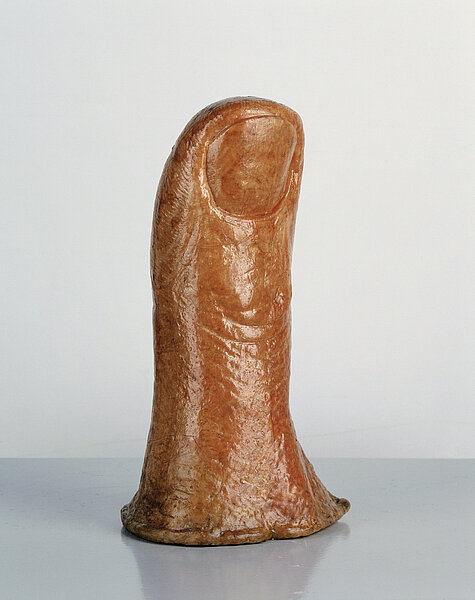
César
Pouce
Thumb
1971
| Object description | Sugar object |
|---|---|
| Object category | sculpture |
| Material | |
| Technique | |
| Dimensions |
Objektmaß:
height: 45 cm,
width: 24 cm,
depth: 20 cm
|
| Year of acquisition | 1978 |
| Inventory number | P 116/0 |
| Creditline | mumok - Museum moderner Kunst Stiftung Ludwig Wien, ehemals Sammlung Hahn, Köln |
| Rights reference | Bildrecht, Wien |
| Further information about the person | César [GND] |
| Literature |
museum moderner kunst.SAMMLUNG HAHN Nouveau Réalisme. Schwerpunkte der Sammlung |
César joined the nouveaux réalistes in 1961 and became well known for his industrially pressed car parts, which often weighed tons and which he himself called “compressions.” From the mid-1960s, his own thumb also became a trademark of his work. His first thumb piece was made for participation in an exhibition on the subject of the hand. Using a pantograph, an instrument for scaling models of different sizes, he made a forty-centimeter sculpture of his own thumb out of transparent pink plastic. In 1971 Daniel Spoerri invited him to make a series of edible thumb sculptures for the Eat Art Gallery in Düsseldorf, among them objects cast of sugar. By isolating and enlarging the thumb and showing all its lines and contours it becomes a strange phallic symbol. We might also recall Heinrich Hoffmann’s mid-nineteenth-century story about “Konrad the Thumb-Sucker,” in which the boy’s oral pleasure is put an end to with scissors. César’s largest thumb was made in 1983 of bronze and is twelve meters high. But César was thinking of other dimensions: “If I could I would make one the size of the Eiffel Tower, lived in and with restaurants.” (César)
© mumok – museum moderner kunst stiftung ludwig wien

